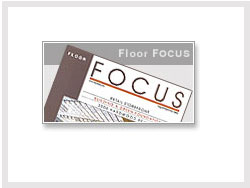Wood Cuts - February 2008
By Rick Berg
Of all the strong selling points for wood flooring—beauty, durability, and ease of maintenance, to name just three—perhaps none is as timely today as the “green” advantage. Consumerism in the 21st century is increasingly being tied to environmentalism, and it will pay to be well attuned to that trend. Recent consumer surveys suggest that 70% or more of consumers would prefer to buy a product that is environmentally friendly. The 2007 Gfk Roper Green Gauge report, for example, found that 79% of consumers said environmental factors influenced their buying decisions.
There’s some debate about how deep that consumer commitment is—how much more buyers are willing to pay for green products, in other words. A November 2007 survey by Deloitte & Touche USA, for example, found that while most consumers said they placed a high value on eco-friendly products, just 17% of consumers said they’d be willing to pay more for them. While that consumer commitment can be debated, the fact remains that if you are selling a product that has a good environmental story to tell, you have a leg up in the sales process.
Healthy
Wood flooring has a great story to tell from both a macro- and micro-environmental perspective. That is, wood flooring is good not only for the environment in the big picture, but also for the interior environment of your customers’ homes, and that’s something your health-conscious customers should know about.
“One of the often untold stories about wood flooring is that because it does not collect dust and allergens, many health professionals say that wood flooring is a good choice for homes where one or more inhabitants suffer from allergies,” says Ed Korczak, CEO and executive director of the National Wood Flooring Association.
In fact, the U.S. Centers for Disease Control estimates that 50 million Americans suffer from some form of allergies and 20 million suffer from asthma. The National Center for Healthy Housing (www.centerforhealthyhousing.org) and others recommend hard surface floors such as hardwood to help eliminate dust, animal dander, microorganisms and other potential allergens in the home.
Renewable
Consumers who buy green focus on many issues, but products that come from renewable resources rank high on their list, and wood flooring fits that bill perfectly. Whether you’re selling wood flooring made from domestic North American hardwoods or from exotic imported species, the good news is that the world’s forests are alive and well and proliferating.
According to a recent report by the University of Georgia Warnell School of Forestry and Natural Resources, the U.S. has one of the world’s largest and most productive forest resources, with more than two billion acres of forest area—and most of it is being managed on a sustainable basis. Overall, annual growth of U.S. forested acres exceeds harvests by 37% each year. The nation’s forest land area is still about two-thirds the size it was 400 years ago, in spite of the conversion of 370 million acres of forest land to other uses, principally to agriculture. The report’s authors add that more trees are growing in America’s forests today than at any time since the early 1900s. Net annual forest growth has increased 62% since 1952, and total growth per acre has increased 71%. Nationally, standing timber volume per acre in U.S. forests is 30% greater today than it was in 1952.
There’s also good news in other parts of the world, according to a November 2006 report in the Proceedings of the National Academy of Sciences.
“Contrary to common belief, forests in many nations are expanding, not shrinking,” the researchers concluded, adding that from 1990 to 2005, forest area increased in 18 of the 50 nations studied.
“There is a trend towards an improvement in forests both in terms of the area they cover and in terms of their condition,” said Roger Sedjo of Resources for the Future, an independent institute in Washington D.C. The researchers used data from the United Nation’s Food and Agriculture Organization.
That’s true for most species in North America, but some imported species have gained environmental cachet. High on the list of renewable wood sources are cork and bamboo, both of which have become increasingly popular in recent years, in part because both species are able to regenerate quickly.
Recyclable
Reclaimed wood flooring has also grown in popularity in recent years, with several companies specializing in the manufacture of wood flooring made from reclaimed structural timbers, as well as timber recovered from river bottoms. If newly harvested timber is environmentally responsible—and it is when it’s harvested from sustainably managed forests—reclaimed wood will appeal even more to some consumers. SmartWood Certification Systems, an international sustainability certification body, estimates that reclaiming one million board feet of lumber preserves one thousand acres of old growth forest.
The National Wood Flooring Association currently lists more than 130 companies specializing in reclaimed wood flooring in 21 species, ranging from beech to walnut.
Sustainable
Many wood flooring manufacturers have gone the extra mile to ensure that their products come from sustainably managed forest resources, whether the source is in North America or elsewhere.
“As an industry, we believe that only wood logged and approved by the country of origin for export should be used in wood flooring,” says NWFA’s Korczak.
You may also find that wood flooring will appeal to a segment of the building trades that emphasizes green building principles. The National Association of Home Builders, for example, has developed a green-building program that recognizes, among other things, the use of renewable and recycled materials such as wood flooring.
Will all of your customers place a high value on eco-friendly flooring? Probably not, but being able to address the green aspects of wood flooring may just be the key selling point that will enable customers to purchase the wood floors they want with a clear environmental conscience.
Copyright 2008 Floor Focus
Related Topics:NWFA Expo
